Satas D., Tracton A.A. (ed.). Coatings Technology Handbook
Подождите немного. Документ загружается.

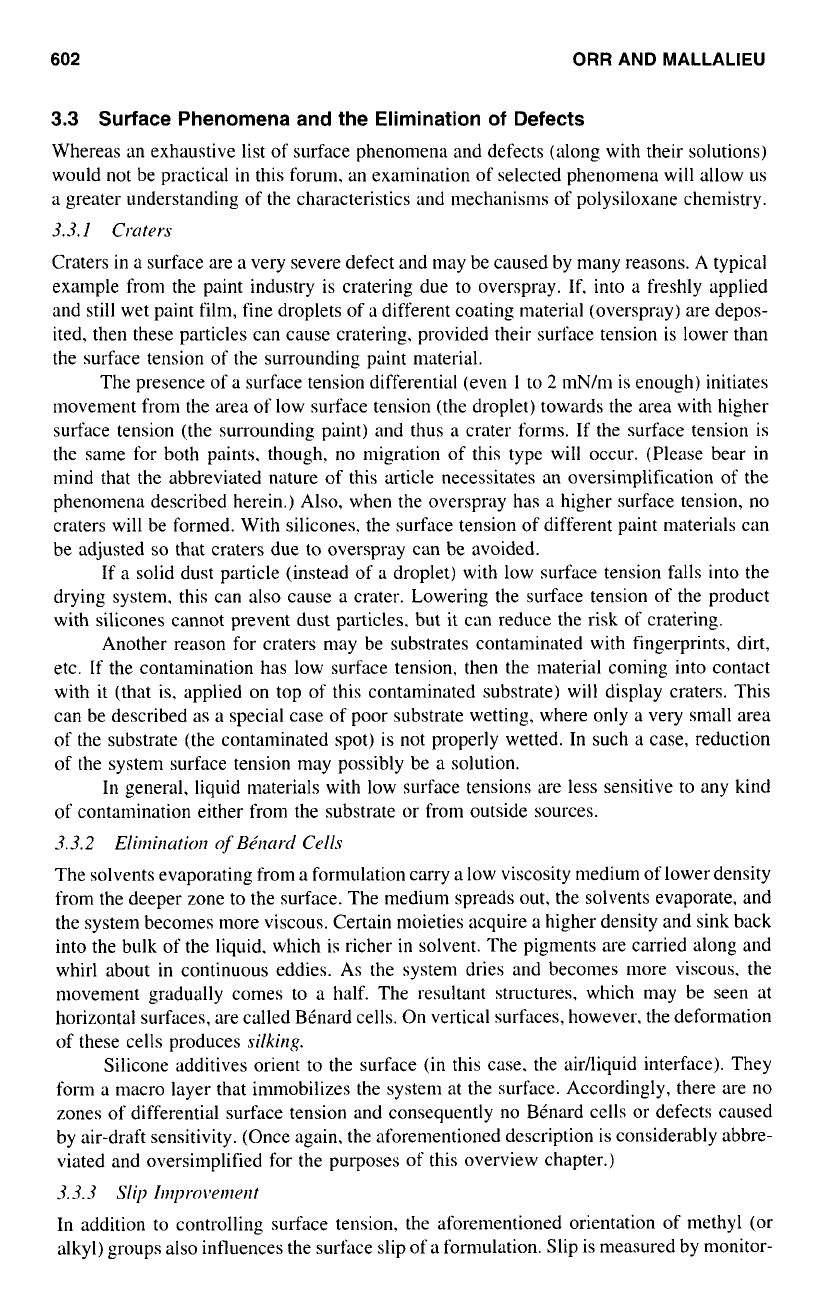
602
ORR
AND MALLALIEU
3.3
Surface Phenomena and the Elimination of Defects
Whereas an exhaustive list
of
surface phenomena and defects (along with their solutions)
would not be practical in this forum, an examination of selected phenomena will allow
us
a greater understanding of the characteristics and mechanisms
of
polysiloxane chemistry.
3.3.
I
Craters
Craters in a surface are a very severe defect and may be caused by many reasons. A typical
example from the paint industry is cratering due to overspray.
If.
into a freshly applied
and still wet paint film, fine droplets of a different coating material (overspray) are depos-
ited, then these particles can cause cratering. provided their surface tension is lower than
the surface tension of the surrounding paint material.
The presence of a surface tension differential (even
1
to
2
mN/m is enough) initiates
movement from the area
of
low surface tension (the droplet) towards the area with higher
surface tension (the surrounding paint) and thus a crater forms. If the surface tension is
the same for both paints, though. no migration of this type will occur. (Please bear in
mind that the abbreviated nature of this article necessitates an oversimplification of the
phenomena described herein.) Also, when the overspray has a higher surface tension, no
craters will be formed. With silicones. the surface tension of different paint materials can
be adjusted
so
that craters due
to
overspray can be avoided.
If a solid dust particle (instead of a droplet) with low surface tension falls into the
drying system. this can
also
cause
a
crater. Lowering the surface tension
of
the product
with silicones cannot prevent dust particles. but it can reduce the risk of cratering.
Another reason for craters may be substrates contanlinated with fingerprints, dirt,
etc.
If
the contamination has low surface tension, then the material coming into contact
with it (that is, applied on top
of
this contaminated substrate) will display craters. This
can be described as a special case of poor substrate wetting, where only a very small area
of the substrate (the contaminated
spot)
is not properly wetted. In such a case, reduction
of the system surface tension may possibly be a solution.
In
general, liquid materials with low surface tensions are less sensitive to any kind
of contamination either from the substrate or from outside sources.
3.3.2
Eliruirlatiorl
of
BPncrrrI
Cells
The solvents evaporating from a formulation carry
a
low viscosity medium of lower density
from the deeper zone
to
the surface. The medium spreads out, the solvents evaporate, and
the system becomes more viscous. Certain moieties acquire
a
higher density and sink back
into the bulk of the liquid, which is richer
in
solvent. The pigments are carried along and
whirl about
in
continuous eddies.
As
the system dries and becomes more viscous. the
movement gradually comes
to
a half. The resultant structures, which may be seen at
horizontal surfaces, are called BCnard cells. On vertical surfaces, however. the deformation
of these cells produces
silkirzg.
Silicone additives orient to the surface
(in
this case. the air/liquid interface). They
form a nlacro layer that immobilizes the system at the surface. Accordingly, there are no
zones of differential surface tension and consequently no Btnard cells or defects caused
by air-draft sensitivity. (Once again, the aforementioned description is considerably abbre-
viated and oversimplified for the purposes of this overview chapter.)
3.3.3
Slip
Improl~enwnt
In addition to controlling surface tension, the aforementioned orientation of methyl (or
alkyl) groups also influences the surface slip
of
a
formulation. Slip is measured by monitor-
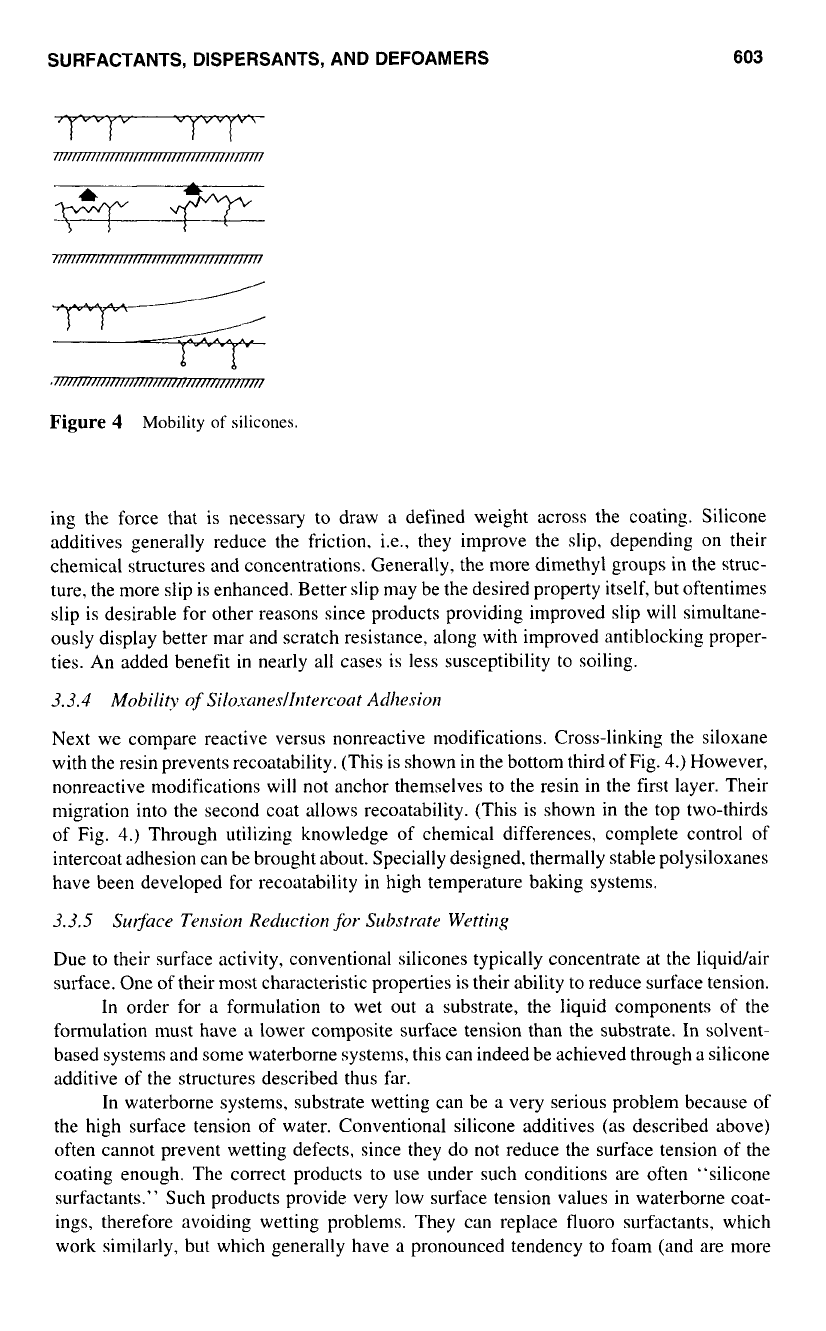
SURFACTANTS, DISPERSANTS, AND DEFOAMERS
603
Figure
4
Mobility
of
silicones.
ing the force that is necessary to draw a defined weight across the coating. Silicone
additives generally reduce the friction, i.e., they improve the slip. depending on their
chemical structures and concentrations. Generally. the more dimethyl groups in the struc-
ture, the more slip is enhanced. Better slip may be the desired property itself. but oftentimes
slip is desirable for other reasons since products providing improved slip will simultane-
ously display better mar and scratch resistance. along with improved antiblocking proper-
ties. An added benefit
in
nearly all cases is less susceptibility to soiling.
3.3.4
Mobility
of
SilosLlrlrslIrlter.corrt
Aclhesion
Next we compare reactive versus nonreactive modifications. Cross-linking the siloxane
with the resin prevents recoatability. (This is shown in the bottom third
of
Fig.
4.)
However,
nonreactive modifications will not anchor themselves
to
the resin in the first layer. Their
migration into the second coat allows recoatability. (This is shown in the top two-thirds
of Fig.
4.)
Through utilizing knowledge of chemical differences, complete control of
intercoat adhesion can be brought about. Specially designed. thermally stable polysiloxanes
have been developed for recoatability in high temperature baking systems.
3.3.5
Sutface
Terwiorl Reduction
for
Substrate
Wetting
Due to their surface activity, conventional silicones typically concentrate at the liquidhir
surface. One of their most characteristic properties is their ability to reduce surface tension.
In order for a formulation to wet out a substrate, the liquid components of the
formulation must have
a
lower composite surface tension than the substrate. In solvent-
based systems and some waterborne systems, this can indeed be achieved through a silicone
additive of the structures described thus far.
In
waterborne systems, substrate wetting can be a very serious problem because of
the high surface tension of water. Conventional silicone additives (as described above)
often cannot prevent wetting defects, since they do
not
reduce the surface tension
of
the
coating enough. The correct products
to
use under such conditions are often “silicone
surfactants.” Such products provide very low surface tension values in waterborne coat-
ings, therefore avoiding wetting problems. They can replace tluoro surfactants, which
work similarly, but which generally have a pronounced tendency to foam (and are more
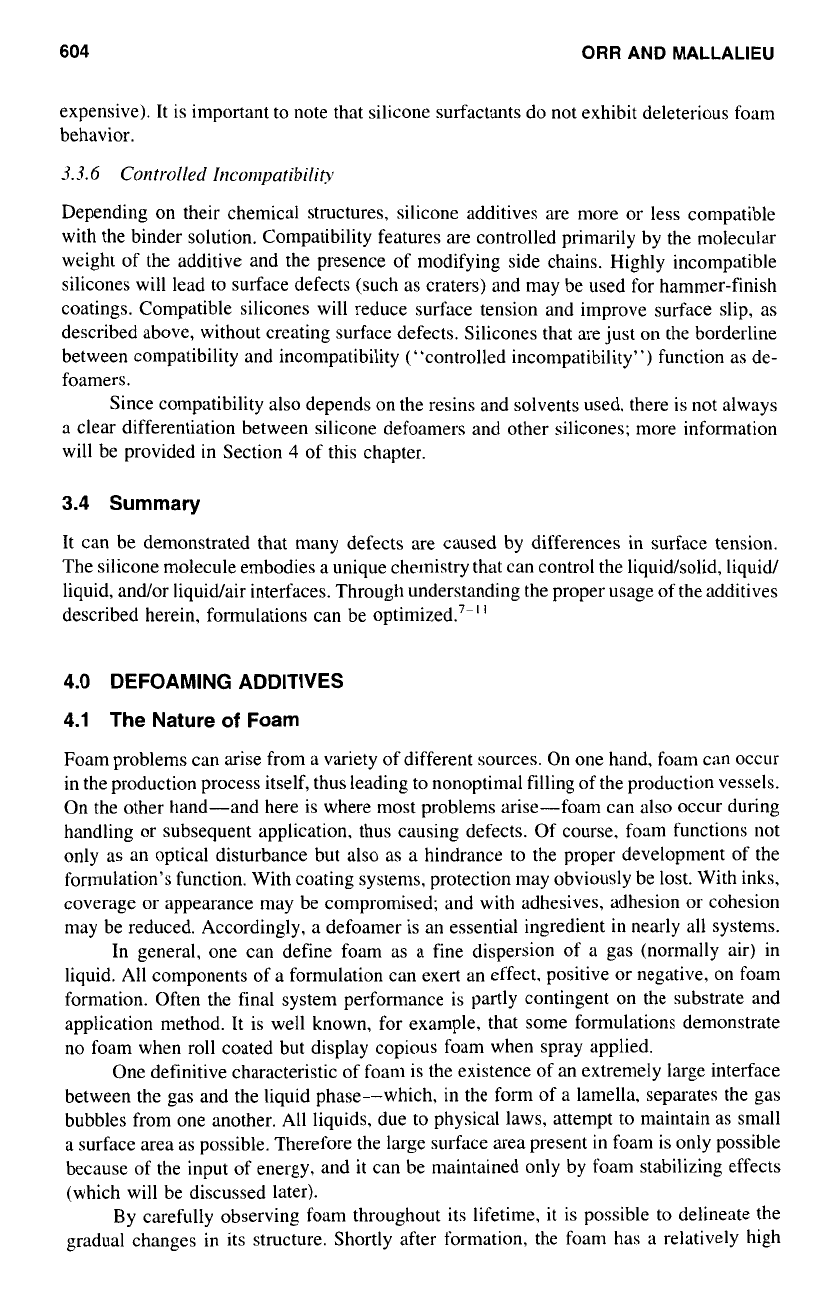
604
ORR
AND MALLALIEU
expensive). It is important
to
note that silicone surfactants do not exhibit deleterious foam
behavior.
3.3.6
Controlled Itlconpatibility
Depending
on
their chemical structures, silicone additives are more or less compatible
with the binder solution. Compatibility features are controlled primarily by the molecular
weight of the additive and the presence
of
modifying side chains. Highly incompatible
silicones will lead to surface defects (such as craters) and may be used for hammer-finish
coatings. Compatible silicones will reduce surface tension and improve surface slip, as
described above, without creating surface defects. Silicones that are just on the borderline
between compatibility and incompatibility (“controlled incompatibility”) function as de-
foamers.
Since compatibility also depends on the resins and solvents used. there is not always
a
clear differentiation between silicone defoamers and other silicones; more information
will be provided in Section
4
of this chapter.
3.4
Summary
It can be demonstrated that many defects are caused by differences in surface tension.
The silicone molecule embodies a unique chemistry that can control the liquid/solid, liquid/
liquid, and/or liquid/air interfaces. Through understanding the proper usage of the additives
described herein, formulations can be optimized.’”’
4.0 DEFOAMING ADDITIVES
4.1
The Nature
of
Foam
Foam problems can arise from a variety of different sources. On
one
hand, foam can occur
in the production process itself, thus leading to nonoptimal filling of the production vessels.
On the other hand-and here is where most problems arise-foam can also occur during
handling or subsequent application, thus causing defects. Of course, foam functions not
only as an optical disturbance but also as a hindrance to the proper development of the
formulation’s function. With coating systems, protection may obviously be lost. With inks,
coverage or appearance may be compromised; and with adhesives, adhesion or cohesion
may be reduced. Accordingly, a defoamer is an essential ingredient
in
nearly all systems.
In general, one can define foam as a fine dispersion of a gas (normally air) in
liquid. All components of a formulation can exert an effect, positive or negative, on foam
formation. Often the final system performance is partly contingent on the substrate and
application method. It is well known, for example, that some formulations demonstrate
no foam when roll coated but display copious foam when spray applied.
One definitive characteristic of foam is the existence
of
an extremely large interface
between the gas and the liquid phase-which, in the form of a lamella, separates the gas
bubbles from one another. All liquids, due
to
physical laws, attempt
to
maintain as small
a surface area as possible. Therefore the large surface area present
in
foam is only possible
because of the input
of
energy, and it can be maintained only by foam stabilizing effects
(which will be discussed later).
By carefully observing foam throughout its lifetime,
it
is possible
to
delineate the
gradual changes in its structure. Shortly after formation, the foam has a relatively high
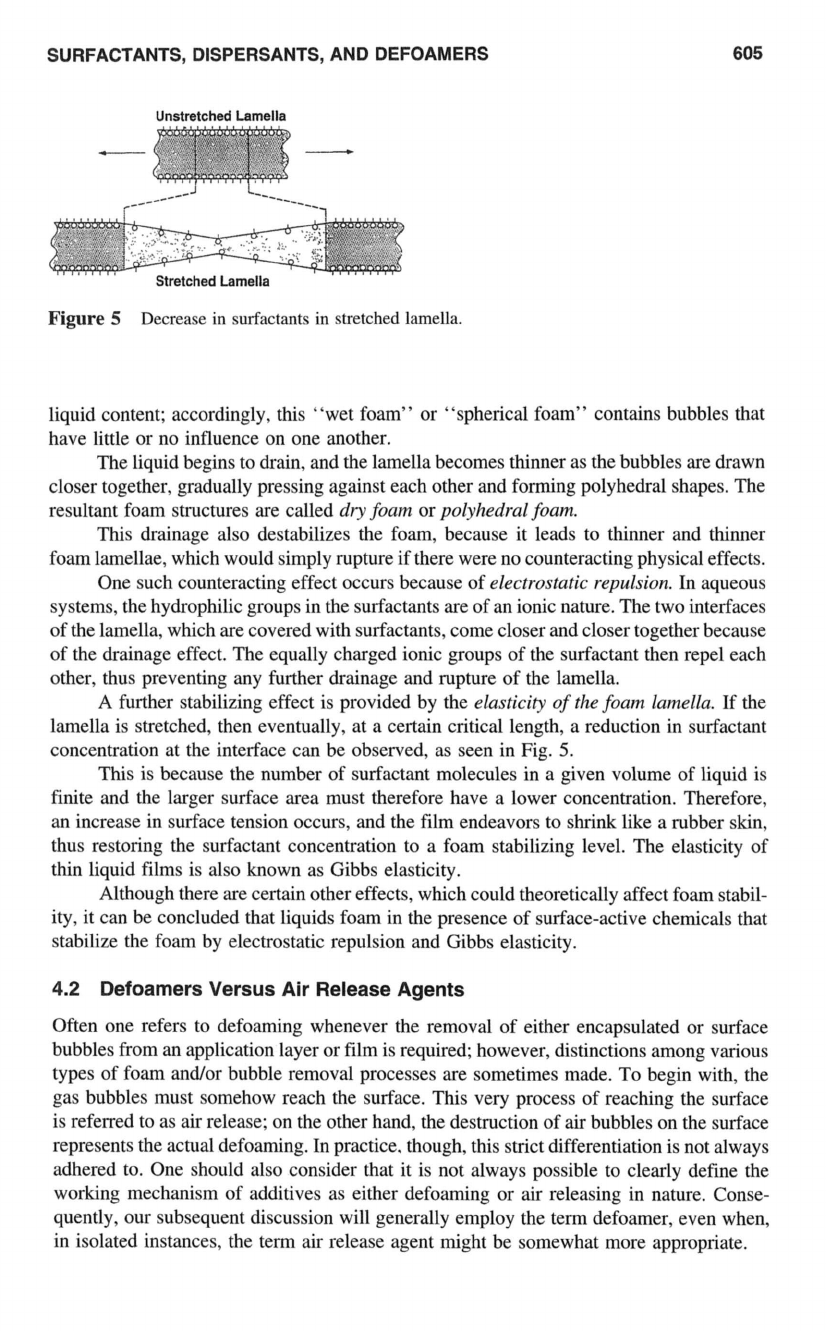
SURFACTANTS, DISPERSANTS, AND DEFOAMERS
605
Unstretched
Lamella
"""J
r"
C"_
""_
Stretched
Lamella
Figure
5
Decrease
in
surfactants
in
stretched lamella.
liquid content; accordingly, this "wet foam"
or
"spherical foam" contains bubbles that
have little
or
no influence on one another.
The liquid begins to drain, and the lamella becomes thinner as the bubbles are drawn
closer together, gradually pressing against each other and forming polyhedral shapes. The
resultant foam structures are called
dry
foam
or
polyhedral foam.
This drainage also destabilizes the foam, because it leads to thinner and thinner
foam lamellae, which would simply rupture if there were no counteracting physical effects.
One such counteracting effect occurs because
of
electrostatic repulsion.
In aqueous
systems, the hydrophilic groups in the surfactants
are
of an ionic nature. The
two
interfaces
of
the lamella, which are covered with surfactants, come closer and closer together because
of the drainage effect. The equally charged ionic groups of the surfactant then repel each
other, thus preventing any further drainage and rupture of the lamella.
A further stabilizing effect is provided by the
elasticity of the foam lamella.
If the
lamella is stretched, then eventually, at a certain critical length, a reduction in surfactant
concentration at the interface can be observed,
as
seen in Fig.
5.
This
is because the number of surfactant molecules in a given volume
of
liquid is
finite and the larger surface area must therefore have a lower concentration. Therefore,
an increase in surface tension occurs, and the film endeavors to shrink like a rubber skin,
thus restoring the surfactant concentration to a foam stabilizing level. The elasticity
of
thin liquid films is also known as Gibbs elasticity.
Although there are certain other effects, which could theoretically affect
foam
stabil-
ity, it can be concluded that liquids foam in the presence of surface-active chemicals that
stabilize the foam by electrostatic repulsion and Gibbs elasticity.
4.2
Defoamers Versus Air Release Agents
Often one refers to defoaming whenever the removal of either encapsulated
or
surface
bubbles from an application layer
or
film is required; however, distinctions among various
types of foam and/or bubble removal processes are sometimes made.
To
begin with, the
gas bubbles must somehow reach the surface. This very process of reaching the surface
is referred to as air release; on the other hand, the destruction of
air
bubbles on the surface
represents the actual defoaming. In practice. though, this strict differentiation is not always
adhered to. One should also consider that it is not always possible to clearly define the
working mechanism of additives as either defoaming
or
air releasing in nature. Conse-
quently,
our
subsequent discussion will generally employ the term defoamer, even when,
in isolated instances, the term air release agent might be somewhat more appropriate.
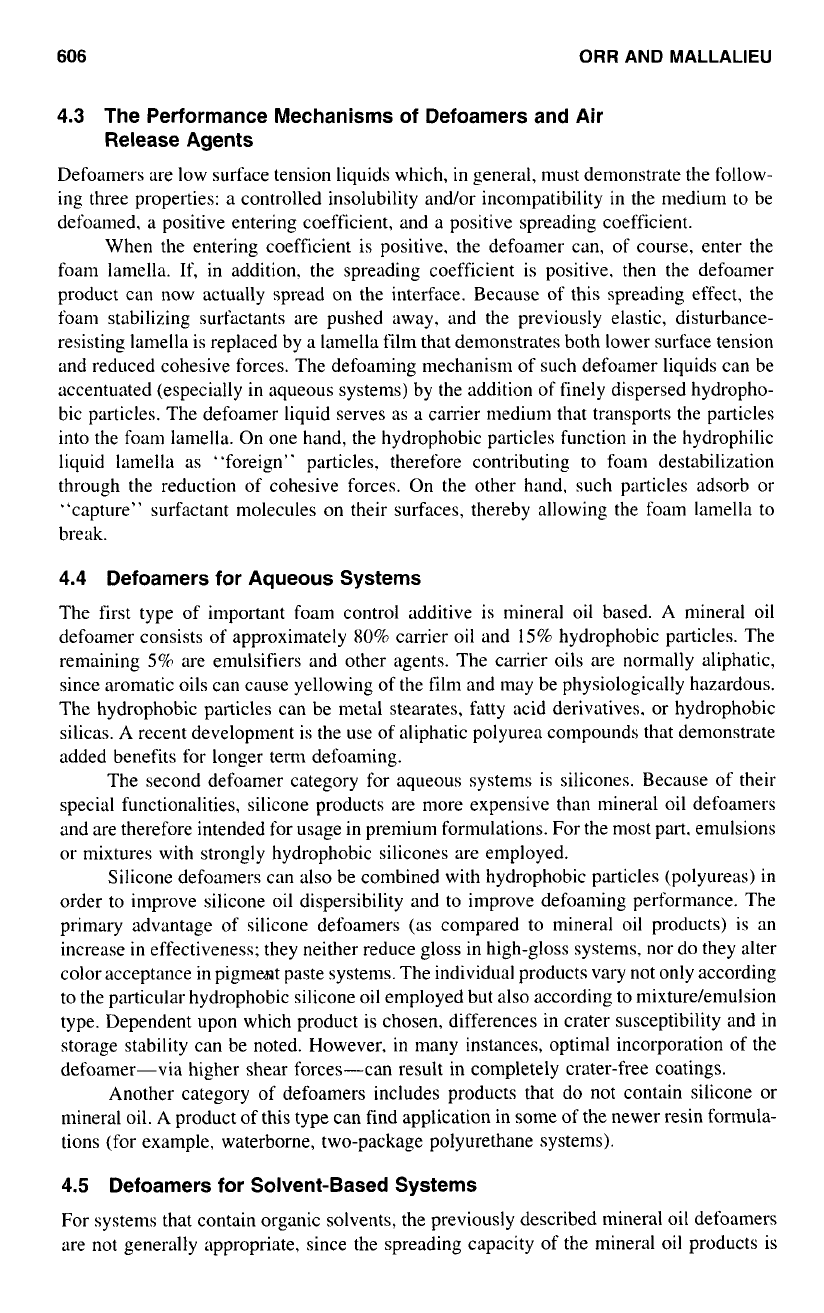
606
ORR
AND MALLALIEU
4.3
The Performance Mechanisms of Defoamers and Air
Release Agents
Defoamers are low surface tension liquids which,
in
general, must demonstrate the follow-
ing three properties: a controlled insolubility and/or incompatibility in the medium to be
defoamed, a positive entering coefficient, and a positive spreading coefficient.
When the entering coefficient is positive, the defoamer can, of course, enter the
foam lamella.
If,
in addition. the spreading coefficient is positive, then the defoamer
product can now actually spread
on
the interface. Because of this spreading effect, the
foam stabilizing surfactants are pushed away. and the previously elastic, disturbance-
resisting lamella is replaced by a lamella film that demonstrates both lower surface tension
and reduced cohesive forces. The defoaming mechanism of such defoamer liquids can be
accentuated (especially in aqueous systems) by the addition of finely dispersed hydropho-
bic particles. The defoamer liquid serves
as
a carrier medium that transports the particles
into the foam lamella. On one hand, the hydrophobic particles function
in
the hydrophilic
liquid Inmella as "foreign" particles. therefore contributing to foam destabilization
through the reduction of cohesive forces. On the other hand. such particles adsorb or
"capture" surfactant molecules
on
their surfaces, thereby allowing the foam lamella to
break.
4.4
Defoamers for Aqueous Systems
The first type of important foam control additive is mineral oil based.
A
mineral oil
defoamer consists
of
approximately
80%
carrier oil and
15%
hydrophobic particles. The
remaining
5%
are emulsifiers and other agents. The carrier oils are normally aliphatic,
since aromatic oils can cause yellowing of the film and may be physiologically hazardous.
The hydrophobic particles can be metal stearates, fatty acid derivatives. or hydrophobic
silicas. A recent development is the use of aliphatic polyurea compounds that demonstrate
added benefits for longer term defoaming.
The second defoamer category for aqueous systems is silicones. Because of their
special functionalities, silicone products are more expensive than mineral oil defoamers
and are therefore intended for usage in premium formulations. For the most part. emulsions
or mixtures with strongly hydrophobic silicones are employed.
Silicone defoamers can also be combined with hydrophobic particles (polyureas) in
order to improve silicone
oil
dispersibility and to improve defoaming performance. The
primary advantage
of
silicone defoamers (as compared to mineral oil products) is an
increase
in
effectiveness; they neither reduce gloss in high-gloss systems, nor do they alter
color acceptance in pigmeat paste systems. The individual products vary not only according
to
the particular hydrophobic silicone
oil
employed but also according to mixture/emulsion
type. Dependent upon which product is chosen, differences in crater susceptibility and in
storage stability can be noted. However, in many instances, optimal incorporation of the
defoamer-via higher shear forces-can result in completely crater-free coatings.
Another category of defoamers includes products that do not contain silicone or
mineral oil. A product of this type can find application in some
of
the newer resin formula-
tions (for example, waterborne, two-package polyurethane systems).
4.5
Defoamers for Solvent-Based Systems
For systems that contain organic solvents, the previously described mineral oil defoamers
are not generally appropriate, since the spreading capacity of the mineral
oil
products is
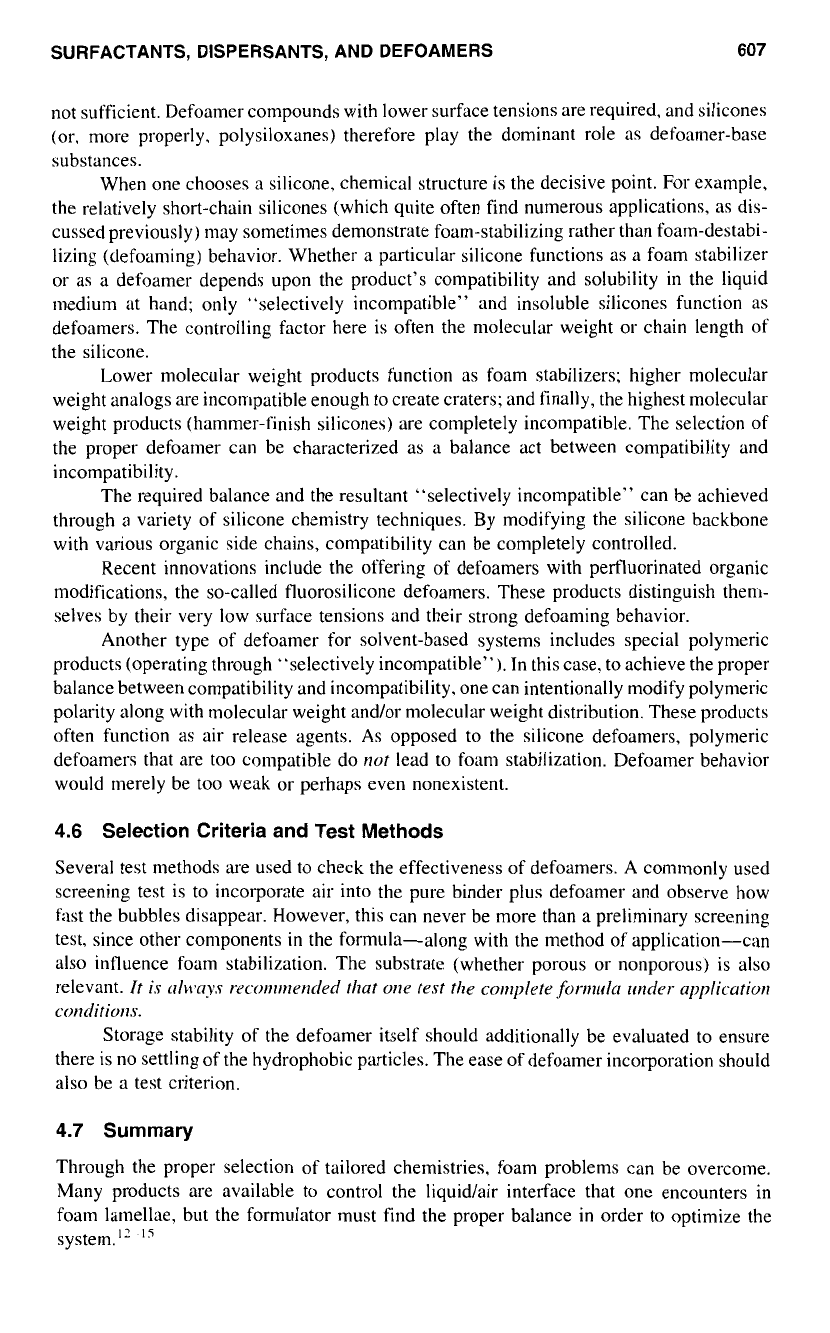
SURFACTANTS, DISPERSANTS, AND DEFOAMERS
607
not sufficient. Defoamer compounds with lower surface tensions are required, and silicones
(or. more properly, polysiloxanes) therefore play the dominant role as defoamer-base
substances.
When one chooses a silicone, chemical structure is the decisive point. For example,
the relatively short-chain silicones (which quite often find numerous applications, as dis-
cussed previously) may sometimes demonstrate foam-stabilizing rather than foam-destabi-
lizing (defoaming) behavior. Whether a particular silicone functions as a foam stabilizer
or as a defoamer depends upon the product’s compatibility and solubility in the liquid
medium at hand; only “selectively incompatible” and insoluble silicones function as
defoamers. The controlling factor here is often the molecular weight or chain length of
the silicone.
Lower molecular weight products function as foam stabilizers; higher molecular
weight analogs are incompatible enough
to
create craters; and finally, the highest molecular
weight products (hammer-finish silicones) are completely incompatible. The selection of
the proper defoamer can be characterized as a balance act between compatibility and
incompatibility.
The required balance and the resultant “selectively incompatible” can be achieved
through a variety of silicone chemistry techniques. By modifying the silicone backbone
with various organic side chains, compatibility can be completely controlled.
Recent innovations include the offering of defoamers with pertluorinated organic
modifications, the so-called fluorosilicone defoamers. These products distinguish them-
selves by their very low surface tensions and their strong defoaming behavior.
Another type of defoamer for solvent-based systems includes special polymeric
products (operating through “selectively incompatible”). In this case.
to
achieve the proper
balance between compatibility and incompatibility, one can intentionally modify polymeric
polarity along with molecular weight and/or molecular weight distribution. These products
often function as air release agents. As opposed to the silicone defoamers, polymeric
defoamers that are too compatible do not lead
to
foam stabilization. Defoamer behavior
would merely be too weak or perhaps even nonexistent.
4.6
Selection Criteria and Test Methods
Several test methods are used to check the effectiveness of defoamers. A commonly used
screening test is to incorporate air into the pure binder plus defoamer and observe how
fast the bubbles disappear. However, this can never be more than a preliminary screening
test, since other components
in
the formula-along with the method of application-can
also influence foam stabilization. The substrate (whether porous or nonporous) is also
relevant. It is L1lktwy.s recorllr~encled that
me
test the cornplete
fonnuh
~rrzdcr
opplicutior~
conrlitior1.s.
Storage stability of the defoamer itself should additionally be evaluated to ensure
there is no settling
of
the hydrophobic particles. The ease of defoamer incorporation should
also be a test criterion.
4.7
Summary
Through the proper selection of tailored chemistries. foam problems can be overcome.
Many products are available to control the liquid/air interface that one encounters in
foam lamellae, but the formulator must find the proper balance
in
order to optimize the
system.’?
l5
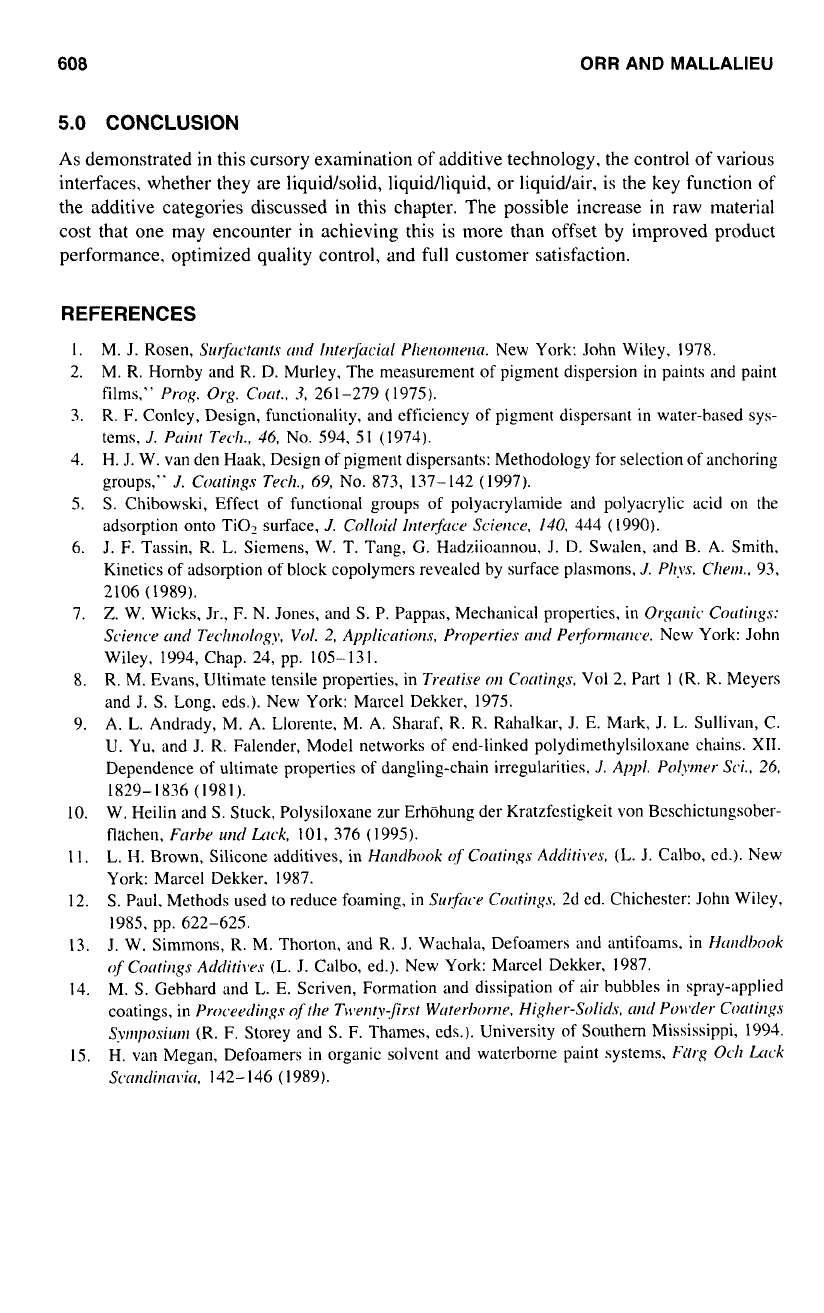
608
ORR
AND MALLALIEU
5.0
CONCLUSION
As
demonstrated in this cursory examination of additive technology, the control of various
interfaces, whether they are liquidkolid, IiquidAiquid, or liquidhir, is the key function
of
the additive categories discussed in this chapter. The possible increase
in
raw material
cost that
one
may encounter in achieving this is more than offset by improved product
performance. optimized quality control, and full custonler satisfaction.
REFERENCES
I.
2.
3.
4.
S.
6.
7.
8.
9.
IO.
I
I.
12.
13.
14.
15
M. J. Rosen,
Surjktrrrl/.s
curd
1nterfi:ltrcictl
Plwrtorrzerm.
New York: John Wiley, 1978.
M. R. Hornby and R. D. Murky. The measurement of pigment dispersion
in
paints and paint
films.”
frog.
Org.
Cor&
3.
261-279 (1975).
R.
F.
Conky, Design, functionality, and efficiency of pigment dispersant
in
water-based sys-
tems,
J.
Pairrf
Tech.,
46,
No. 594.
S1
(1974).
H. J. W. van den Haak, Design of pigment dispersants: Methodology for selection of anchoring
groups,”
J.
Cocrtirtg.~
Tech.,
69,
No. 873, 137-142 (1997).
S.
Chibowski, Effect of functional groups of polyacrylamide and polyacrylic acid on the
adsorption onto TiOz surface.
J.
Colloid
hrterfi~e
Scier~ce.
140.
444
(
1990).
J.
F.
Tassin, R. L. Siemens, W. T. Tang,
G.
Hadziioannou, J.
D.
Swalen, and B.
A.
Smith,
Kinetics of adsorption of block copolymers revealed by surface plasmons,
J.
P/r!).s.
Cherrl..
93,
2106
(1989).
Z.
W. Wicks, Jr..
F.
N.
Jones, and
S.
P. Pappas, Mechanical Properties, in
Orgtrr~ic
Cocthgs:
Scier~ce
ctrd
Techrrology.
Vol.
2,
Applicmions,
Properties
md
Performrrtce.
New York: John
Wiley, 1994, Chap. 24, pp.
105-131.
R.
M. Evans, Ultimate tensile properties, in
Tre~ttise
OII
Corrtirlg.~,
Vol
2, Part
1
(R.
R. Meyers
and
J.
S.
Long. eds.). New York: Marcel Dekker, 1975.
A.
L.
Andrady, M. A. Llorente,
M.
A.
Sharaf, R. R. Rahalkar, J. E. Mark, J. L. Sullivan, C.
U.
Yu. and J. R. Falender, Model networks of end-linked polydimethylsiloxanc chains.
XII.
Dependence
of
ultimate propertics of dangling-chain irregularities.
J.
Appl.
Po/yrrzer
Sci..
26.
W. Heilin and
S.
Stuck, Polysiloxane zur Erhohung der Kratzfestigkeit von Bcschictungsober-
fl:ichen,
Furbe
urd
Dick,
101,
376 (1995).
L.
H. Brown, Silicone additives, in
Hnrrdhook
of
COLI/~II~.S
Ar/rli/i,.es,
(L.
J.
Calbo,
d.).
New
York: Marcel Dekker. 1987.
S.
Paul. Methods used to reduce foaming,
in
Su$u
Cotrtirrgs.
2d
ed. Chichester: John Wilcy,
J.
W. Simmons, R. M. Thorton, and R. J. Wachala, Defoamers and antifoams.
in
Herrldbook
of
CootirIgs
Arlditi,v.s
(L. J. Calbo, ed.). New York: Marcel Dekker, 1987.
M.
S.
Gebhard and L. E. Scriven, Formation and dissipation of air bubbles
in
spray-applied
coatings, in
Proc~erclirrg,s
of
/he
T\tvrrtyjir.s/
Wctterl)orrre.
Higher-Solids,
COK/
Po~~ler
CoatirlLs.s
Syrj~po.siurll
(R.
F.
Storey and
S. F.
Thames. eds.). University
of
Southern Mississippi, 1993.
H. van Megan, Defoamers in organic solvent and waterborne paint systems.
Flirg
och
hck
1829-1836 (1981).
1985,
pp. 622-625.
Scr/dirlm~i~/.
142-146 (1989).
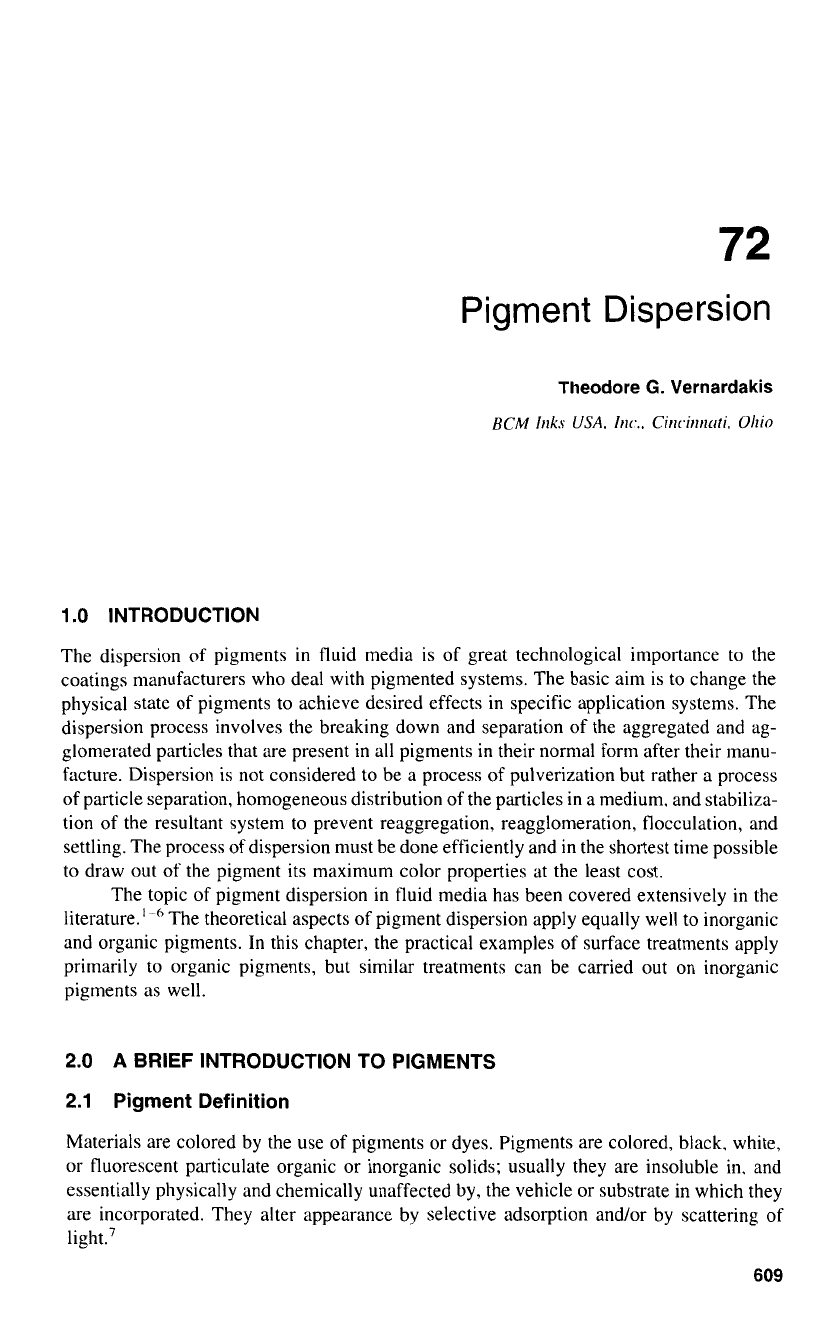
72
Pigment Dispersion
1
.O
INTRODUCTION
The dispersion of pigments
in
fluid media is of great technological importance
to
the
coatings manufacturers who deal with pigmented systems. The basic aim is to change the
physical state of pigments to achieve desired effects in specific application systems. The
dispersion process involves the breaking down and separation
of
the aggregated and ag-
glomerated particles that are present
in
all pigments in their normal form after their manu-
facture. Dispersion is not considered to be a process
of
pulverization but rather a process
of particle separation, homogeneous distribution
of
the particles in a medium. and stabiliza-
tion of the resultant system to prevent reaggregation, reagglomeration, flocculation, and
settling. The process
of
dispersion must be done efficiently and
in
the shortest time possible
to draw out
of
the pigment its maximum color properties at the least cost.
The topic of pigment dispersion in fluid media has been covered extensively in the
literature."6 The theoretical aspects
of
pigment dispersion apply equally well to inorganic
and organic pigments. In this chapter, the practical examples of surface treatments apply
primarily to organic pigments, but similar treatments can be carried out on inorganic
pigments as well.
2.0
A
BRIEF
INTRODUCTION TO PIGMENTS
2.1
Pigment Definition
Materials are colored by the use of pigments or dyes. Pigments are colored, black. white,
or fluorescent particulate organic or inorganic solids; usually they are insoluble in. and
essentially physically and chemically unaffected by, the vehicle or substrate in which they
are incorporated. They alter appearance by selective adsorption and/or by scattering of
light.'
609
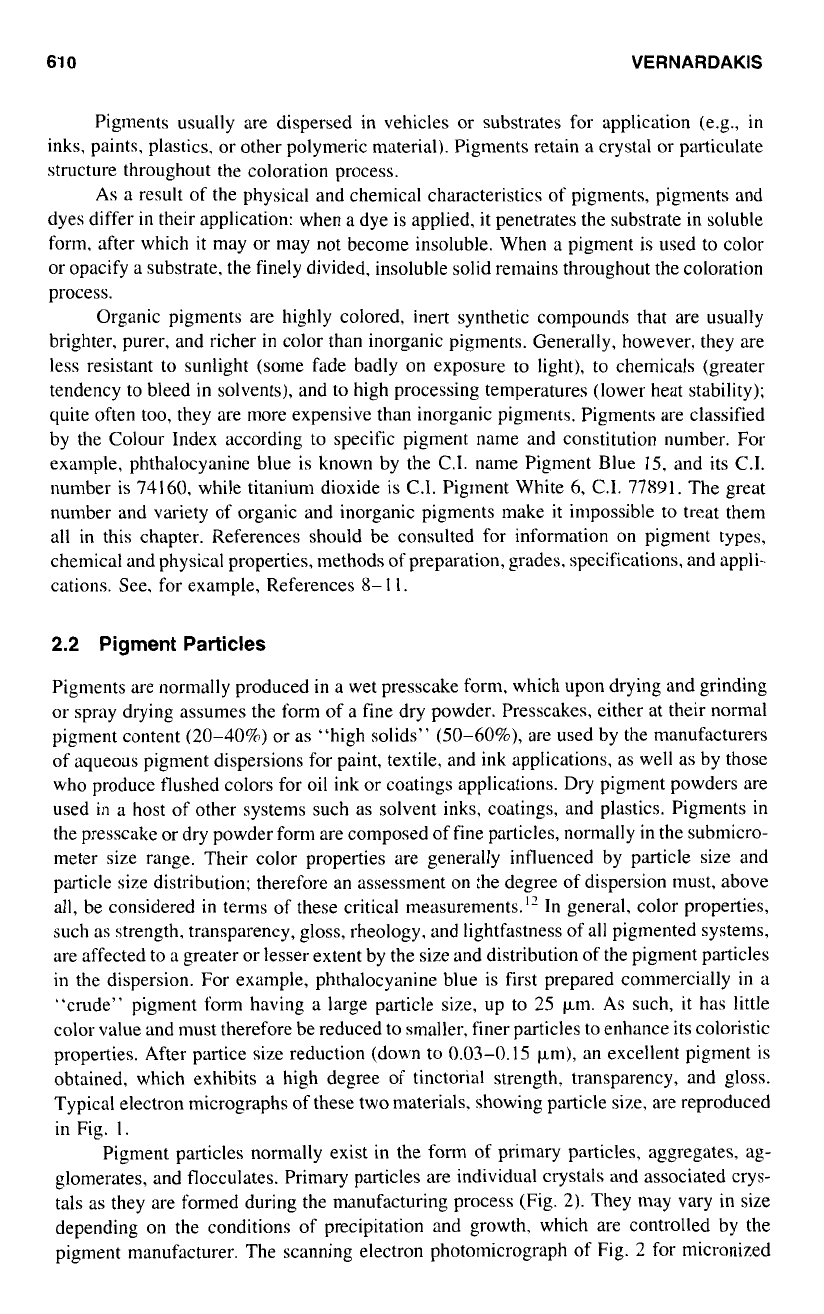
61
0
VERNARDAKIS
Pigments usually are dispersed in vehicles or substrates for application (e.g.,
in
inks, paints, plastics, or other polymeric material). Pigments retain a crystal or particulate
structure throughout the coloration process.
As a result of the physical and chemical characteristics of pigments, pigments and
dyes differ
in
their application: when a dye is applied,
it
penetrates the substrate in soluble
form. after which
it
may or may not become insoluble. When
a
pigment is used to color
or opacify a substrate, the finely divided, insoluble solid remains throughout the coloration
process.
Organic pigments are highly colored, inert synthetic compounds that are usually
brighter, purer, and richer
in
color than inorganic pigments. Generally, however, they are
less resistant
to
sunlight (some fade badly on exposure to light), to chemicals (greater
tendency to bleed
in
solvents), and
to
high processing temperatures (lower heat stability);
quite often too, they are more expensive than inorganic pigments. Pigments are classified
by the Colour Index according to specific pigment name and constitution number. For
example, phthalocyanine blue is known by the
(2.1.
name Pigment Blue
15,
and its C.I.
number is
74160,
while titanium dioxide is C.1. Pigment White
6,
(2.1.
77891.
The great
number and variety of organic and inorganic pigments make
it
impossible
to
treat them
all
in
this chapter. References should be consulted for information on pigment types,
chemical and physical properties, methods
of
preparation, grades. specifications, and appli-
cations. See. for example, References
8-
1 1.
2.2
Pigment
Particles
Pigments are normally produced in
a
wet presscake form, which upon drying and grinding
or spray drying assumes the form of
a
fine dry powder. Presscakes, either at their normal
pigment content
(20-40%)
or
as
“high solids”
(50-60%),
are used by the manufacturers
of aqueous pigment dispersions for paint, textile, and ink applications.
as
well
as
by those
who produce flushed colors for oil ink or coatings applications. Dry pigment powders are
used
in
a host of other systems such as solvent inks, coatings, and plastics. Pigments in
the presscake or dry powder form are composed of fine particles, normally
in
the submicro-
meter size range. Their color properties are generally influenced by particle size and
particle size distribution; therefore an assessment
on
the degree of dispersion must, above
all, be considered
in
terms of these critical measurements.”
In
general, color properties,
such as strength, transparency, gloss, rheology, and lightfastness
of
all pigmented systems,
are affected to a greater or lesser extent by the size and distribution of the pigment particles
in the dispersion. For example, phthalocyanine blue is first prepared commercially
in
a
“crude” pigment form having a large particle size, up to
25
pm.
As such, it has little
color value and must therefore be reduced to smaller, finer particles to enhance its coloristic
properties. After partice size reduction (down to
0.03-0.15
km), an excellent pigment is
obtained, which exhibits a high degree of tinctorial strength, transparency, and gloss.
Typical electron micrographs
of
these two materials. showing particle size, are reproduced
in Fig.
1.
Pigment particles normally exist in the form
of
primary particles, aggregates, ag-
glomerates, and flocculates. Primary particles are individual crystals and associated crys-
tals as they are formed during the manufacturing process (Fig.
2).
They may vary in size
depending on the conditions of precipitation and growth. which are controlled by the
pigment manufacturer. The scanning electron photomicrograph
of
Fig.
2
for micronized
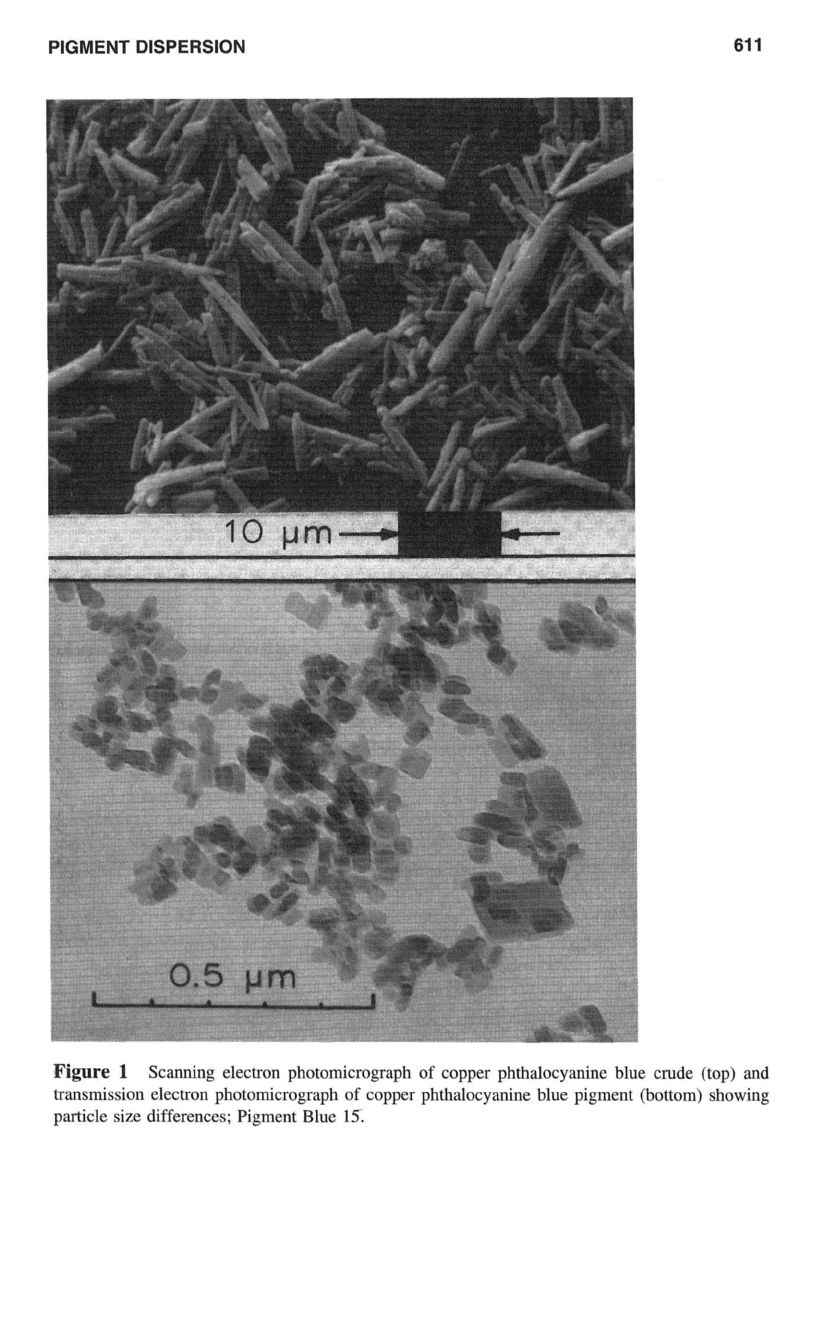
PIGMENT DISPERSION
61
1
Figure
1
Scanning electron photomicrograph of copper phthalocyanine blue crude (top) and
transmission electron photomicrograph
of
copper phthalocyanine blue pigment (bottom) showing
particle size differences; Pigment Blue
15.
